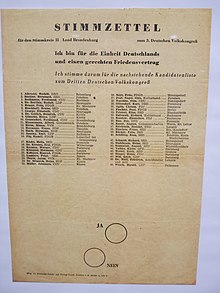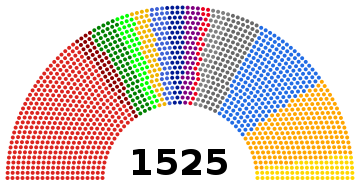| Revision as of 18:47, 28 November 2013 editHangingCurve (talk | contribs)Autopatrolled, Extended confirmed users, Pending changes reviewers, Rollbackers100,994 edits add refs← Previous edit |
Latest revision as of 22:05, 22 February 2024 edit undoSegagustin (talk | contribs)Extended confirmed users2,131 edits →top: East German flag from 1949-59Tags: Mobile edit Mobile app edit Android app edit |
| (51 intermediate revisions by 26 users not shown) |
| Line 1: |
Line 1: |
|
|
{{Short description|none}} |
|
'''Elections for a Constitutional Assembly''' were held in ] in May 1949.<ref name=NS>] & Stöver, P (2010) ''Elections in Europe: A data handbook'', p771 ISBN 978-3-8329-5609-7</ref> Voters were presented with a "Unity List" from the "]," which in turn was dominated by the Communist ].<ref name=NS/> They only had the option of approving or rejecting the list. In much of the country, the vote was not secret.<ref name=Britannica> at </ref> |
|
|
|
{{Use dmy dates|date=March 2017}} |
|
|
{{Infobox election |
|
|
| country = East Germany |
|
|
| flag_year = 1949 |
|
|
| type = parliamentary |
|
|
| turnout = 95.23% |
|
|
| election_date = 15–16 May 1949 |
|
|
| previous_election = 1938 German parliamentary election and referendum |
|
|
| previous_year = 1938<br>{{small|(pre-partition)}} |
|
|
| next_election = 1950 East German general election |
|
|
| next_year = 1950 |
|
|
| seats_for_election = All 1,525 seats in the ] |
|
|
| image1 = Fotothek df roe-neg 0002793 004 Portrait Wilhelm Piecks im Publikum der Bachfeier.jpg |
|
|
| leader1 = ] |
|
⚫ |
| alliance1= ] |
|
|
| party1 = Socialist Unity Party of Germany |
|
|
| leader_since1 = 22 April 1946 |
|
|
| seats1 = 450 |
|
|
| title = Chairman of the Council of Ministers |
|
|
| posttitle = Chairman of the Council of Ministers after election |
|
|
| after_election = ] |
|
|
| after_party = Socialist Unity Party of Germany |
|
|
}}{{Politics of East Germany}} |
|
|
] |
|
|
|
|
|
|
] for the ] were held in ] on 15 and 16 May 1949.<ref>Dirk Spilker (2006) ''The East German Leadership and the Division of Germany: Patriotism and Propaganda 1945-1953'', Clarendon Press, p184</ref> Voters were presented with a "Unity List" from the "]," which was dominated by the Communist-leaning ] (SED).<ref name=NS/> The ballot was worded "''I am for the unity of Germany and a just ]. I therefore vote for the following list of candidates for the Third German People's Congress,''"<ref> at ]</ref> with voters having the options of voting "yes" and "no".<ref> Direct Democracy</ref> In much of the country, the vote was not secret.<ref name=Britannica> at ]</ref> |
| ⚫ |
According to official figures, 95.2% of voters turned out, and 66% of them approved the list.<ref name=NS/> This would be the lowest vote share an SED-dominated bloc would claim during the four decades of Communist rule in East Germany. In subsequent years the ], successor to the Democratic Bloc, would claim to win vote shares in excess of 99%.<ref name=Britannica/> |
|
|
|
|
|
⚫ |
According to official figures, 95.2% of voters voted, and 66% of them approved the list,<ref name=NS>] & Phillip Stöver (2010) ''Elections in Europe: A data handbook'', p771 {{ISBN|978-3-8329-5609-7}}</ref> the lowest vote share an SED-dominated bloc received during the subsequent four decades of Communist rule. In all subsequent elections until the ], the ], successor to the Democratic Bloc, would win 99 percent or more of the vote.<ref name=Britannica/> |
|
|
|
|
|
==Results== |
|
==Results== |
|
|
{{Election results |
|
{| class=wikitable style=text-align:right |
|
|
|
|image=] |
|
!Choice |
|
|
|
|alliance1=]|aspan1=14|party1=]|votes1=7943949|vspan1=14|seats1=450|acolor1=#DC241F |
|
!Votes |
|
|
|
|party2=]|seats2=225 |
|
!% |
|
|
|
|party3=]|seats3=225 |
|
|- |
|
|
|
|party4=Cooperatives|seats4=100 |
| ⚫ |
|align=left|]||7,943,949||66.1 |
|
|
|
|party5=]|seats5=75 |
|
|- |
|
|
|
|party6=]|seats6=75 |
|
|align=left|Against||4,080,272||33.9 |
|
|
|
|party7=]|seats7=50 |
|
|- |
|
|
|
|party8=]|seats8=50 |
|
|align=left|Invalid/blank votes||863,013||– |
|
|
|
|party9=]|seats9=50 |
|
|- |
|
|
|
|party10=]|seats10=50 |
|
|align=left|'''Total'''||'''12,887,234'''||'''100''' |
|
|
|
|party11=]|seats11=50 |
|
|- |
|
|
|
|party12=]|seats12=50 |
|
|align=left|Registered voters/turnout||13,533,071||95.2 |
|
|
|
|party13=] (East Berlin)|seats13=25 |
|
|- |
|
|
|
|party14=Independents|seats14=50 |
|
|align=left colspan=3|Source: Nohlen & Stöver |
|
|
|
|row15=Against|votes15=4080272 |
| ⚫ |
|} |
|
|
|
|invalid=863013 |
|
|
|electorate=13533071 |
|
|
|source=Nohlen & Stöver |
|
⚫ |
}} |
|
|
|
|
|
==Aftermath== |
|
==Aftermath== |
|
The Constitutional Assembly adopted ] in October, and proclaimed the establishment of the German Democratic Republic on 7 October. It then transformed itself into the first ] ''(Volkskammer)'' of East Germany. |
|
The Constitutional Assembly adopted ] in October, and proclaimed the establishment of the German Democratic Republic on 7 October. It then transformed itself into the first ]. |
|
|
|
|
|
==References== |
|
==References== |
| Line 29: |
Line 59: |
|
|
|
|
|
{{East German elections}} |
|
{{East German elections}} |
|
|
{{Authority control}} |
|
|
|
|
|
] |
|
] |
|
] |
|
] |
|
] |
|
] |
|
] |
|
] |
|
|
] |
|
|
] |
|
|
] |
|
|
] |
|
|
|
|
|
{{Germany-election-stub}} |
|
{{Germany-election-stub}} |
According to official figures, 95.2% of voters voted, and 66% of them approved the list, the lowest vote share an SED-dominated bloc received during the subsequent four decades of Communist rule. In all subsequent elections until the Peaceful Revolution, the National Front, successor to the Democratic Bloc, would win 99 percent or more of the vote.



